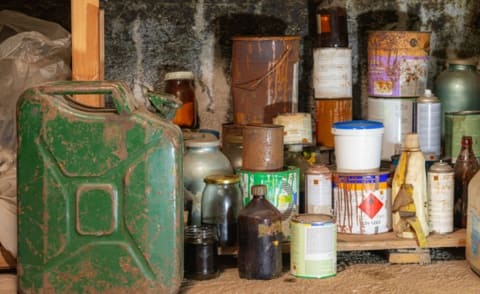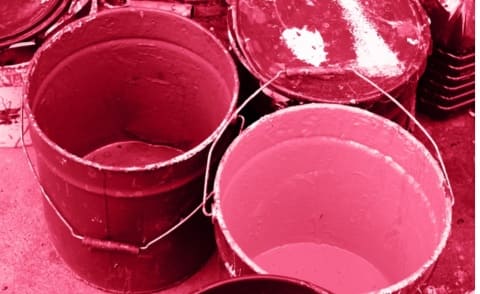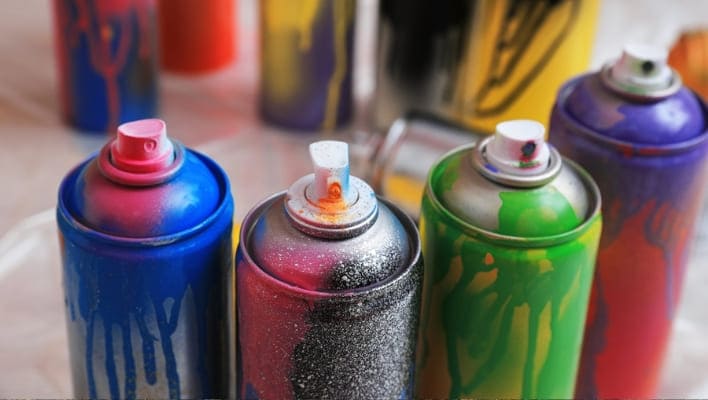Paint can often remain usable for an extended period if it has been stored in conditions away from extreme humidity and temperatures, even beyond its designated shelf life.
As long as your paint doesn’t emit a foul odor or exhibit an unusual consistency, there could be NO dangers of using old paint on walls and house and it can still serve its purpose for touch-ups or new projects.
However, you must note that old paint could be used, but the final result may not be flawless.

Table of Contents
- Can You Use Old Paint That Has Separated?
- How To Know If Paint Is Bad?
- What happens when you use old paint? (Dangers Of Using Old Paint)
- How can you tell if the paint has mold?
- How Long Can You Use Paint After Opened?
- How to make old paint usable again?
- Is it OK to use paint that has been frozen?
- What can I do with a lot of leftover paint?
- Touch-Ups:
- Small Projects:
- Donate:
- Share with Neighbors:
- Art and Craft:
- Mural or Accent Wall:
- Recycle or Dispose Properly:
- Final Thoughts
- FAQs on can we use expired paint
- Q. What happens when we use old paint?
- Q. How long does Dulux paint last once opened?
- Q. Does old paint change color?
- Jennifer Marie
Can You Use Old Paint That Has Separated?
If you notice that your paint has separated into two layers, one semi-transparent and the other opaque, you can attempt to restore it by stirring.
After stirring, allow it to sit for a few minutes. If the paint quickly separates again, this indicates that it has likely expired and should not be used. This is because the solvent and pigment in the paint are no longer able to effectively blend and adhere to the surface.
How To Know If Paint Is Bad?
- Smell: One way to detect bad paint is by its odor. If the paint has a sour smell similar to spoiled milk or emits a rancid, it has likely gone bad.
- Texture: Another indicator is the texture of the paint. If the paint has developed a chunky consistency or has become lumpy it is a sign that it has deteriorated.
What happens when you use old paint? (Dangers Of Using Old Paint)

Using old paint that smells sour and has lumpy texture can lead to various issues:
- Old paint, particularly when it has degraded, can emit increased levels of VOCs when used. Inhaling these VOCs can lead to respiratory irritation, dizziness, headaches, and, in severe cases, more serious health issues.
- Old paint may not adhere properly, causing bubbling, peeling or cracking. This can result in an unstable and unattractive surface.
- When old paint is applied, it may spread unevenly, leaving streaks and color variations. Achieving a smooth, uniform appearance becomes challenging.
- Over time, old paint can change in color, leading to a noticeable mismatch between touch-ups and existing paint on your walls, compromising the visual cohesion.
- Old paint often doesn’t cover as effectively as fresh paint, necessitating more coats to achieve the desired coverage. This can be time-consuming and costly.
- If stored in humid conditions, paint could build up bacteria and mold, posing health hazards and affecting indoor air quality.
- If the paint has separated into layers, stirring may not fully restore its consistency. The pigment and solvent of the paint can be unevenly distributed during application as a result.
- Using old, problematic paint can lead to wasted time, effort, and resources, as you may need to redo the painting job sooner than expected to achieve a satisfactory result.
How can you tell if the paint has mold?
Determining if paint contains mold involves visual inspection and an odor assessment. Mold on paint appears as discolored, fuzzy, or powdery spots, often in shades of green, black, or brown.
Old paint can become susceptible to mold growth, particularly if kept in damp or humid environments. To prevent mold, store paint cans in a cool, dry place, seal them tightly, and consider adding a mold-resistant additive. If mold is detected, it’s crucial to address it promptly to prevent further contamination and ensure a healthy indoor environment.
How Long Can You Use Paint After Opened?
Once a can of interior paint has been opened, it typically remains usable for an average of 5 years when stored correctly with a proper seal.
However, the average life of old paint may vary as per the paint type. Unopened cans of acrylic or latex paint, on the other hand, can last for up to 10 years.
How to make old paint usable again?

- You can use old paint for touch ups. Begin by thoroughly stirring the old paint using a paint stirrer or a wooden stick. This helps redistribute pigments and solids that may have settled over time.
- Gradually add a paint conditioner or paint thinner to the old paint. Start with a small amount while mixing until you reach the ideal consistency. This step helps rejuvenate the paint’s texture.
- Ensure that the paint and conditioner/thinner are mixed together thoroughly. Consistency is key to getting the old paint back to a usable state.
- To eliminate any lumps or debris that may have formed, strain the paint through a mesh or nylon paint strainer. This step ensures a smoother application.
- Before using the paint on your intended project, it’s essential to test it on a small surface. This test ensures that the paint adheres properly and dries as expected.
- After you’re done, seal the paint tightly to prevent it from drying out. Proper sealing maintains the paint’s quality for future use.
- Don’t forget to label the paint can with the color and the date you modified it. This labeling helps you identify the paint easily and track its freshness.
- If you have any unusable or expired paint left, dispose of it following local regulations and guidelines to ensure environmental responsibility.
Is it OK to use paint that has been frozen?
Using paint that has been frozen is not a good idea because freezing can harm its quality. When paint freezes, it can lead to several problems:
- Separation: Freezing can make the parts of paint, like colors and binders, separate. This makes the paint lumpy and hard to mix evenly.
- Texture Changes: The freezing and thawing process can make the paint thicker or thinner than it should be. This can make it tricky to apply and may not cover surfaces well.
- Not Working Properly: Frozen paint may not stick to surfaces properly, dry correctly, or give you the finish you want. It might also lose its color and look faded.
To get the best results, it’s better to use fresh paint instead of paint that has been frozen.
What can I do with a lot of leftover paint?
Having a surplus of leftover paint can be a common issue after a home improvement project. Here are several practical and creative ways to make the most of your excess paint:
Touch-Ups:
Save the paint for future touch-ups on walls, furniture, or other items in your home. Properly label the paint cans with details like color, room, and date for easy reference.
Small Projects:
Use the leftover paint for smaller DIY projects, such as repainting picture frames, shelves, or outdoor furniture. It can give these items a fresh look.
Donate:
If you have unopened and unused paint, consider donating it to local schools, community centers, or nonprofit organizations. They might have a need for it.
Offer the extra paint to your neighbors or friends who may be working on their own projects.
Art and Craft:
Artists and craft enthusiasts can find uses for leftover paint in various projects. You can create custom art pieces, decorative accents, or even hand-painted greeting cards.
Mural or Accent Wall:
Use the paint for a mural or to create an accent wall in your home. This can add a unique and personalized touch to your living space.
Recycle or Dispose Properly:
If you have paint that you can’t use and don’t want to store, check local regulations for proper disposal methods. Many communities have hazardous waste disposal programs for paint.
Final Thoughts
There may not be dangers of using oil paint when stored properly. However, it may lead to adhesion problems, color discrepancies, and health hazards if it’s gone bad. To restore old paint, stir it, add a conditioner or thinner, strain, and test on a small surface.
Fresh paint is often a better choice for a flawless finish, and always follow age restrictions for spray paint purchases to promote safe usage.
FAQs on can we use expired paint
Q. What happens when we use old paint?
Adhesion problems can result from using expired paint. Additionally, it can pose health hazards due to the release of excessive paint fumes or volatile organic compounds (VOCs). In some cases, old paint may still be usable if the solids have separated from the water component. However, it’s generally advisable to opt for new paint when in doubt.
Q. How long does Dulux paint last once opened?
When handled with care and sealed properly, opened Dulux paint can typically remain usable for a minimum of one year. It’s worth noting that the way you open and close the paint can also plays a role in prolonging its shelf life. Improperly opening a can may damage the lid’s seal, potentially allowing air to enter when resealed.
Q. Does old paint change color?
As time passes, exposure to dirt and sunlight can subtly modify the paint color and shade. While this transformation may go unnoticed by those who regularly observe the paint, it becomes glaringly evident when fresh paint is applied, revealing that the colors have indeed shifted over time.

Jennifer Marie
Jennifer Marie is a general contractor with over the years of experience in home remodeling, DIY projects, and commercial painting projects. Her experience includes working with paint sprayers, painting tools, and other painting supplies. You can follow her on Facebook.


